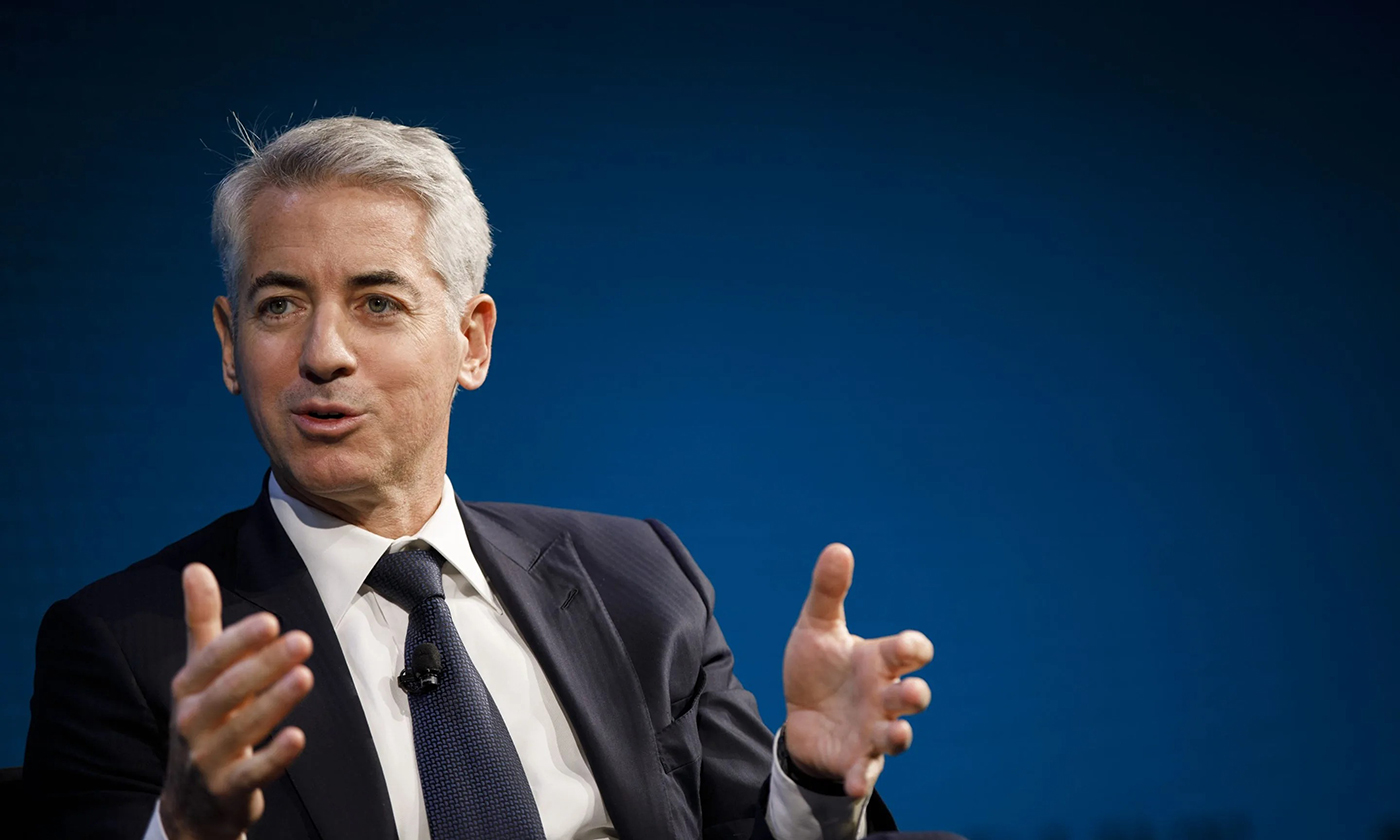
美联储有两项简单却极难完成的工作,一是确保最大就业,二是维持物价稳定。
美联储今年维持物价稳定的难度之大,甚至用“挑战”一词都不足以形容。
美联储官员设定的年化通胀目标是2%(以个人消费支出价格指数——PCE计算),然而随着通胀一路飙升至四十年新高,今年他们距这一数字可谓所去甚远。为了应对这轮历史级的物价上涨,美联储在2022年已经七次加息。
潘兴广场资本管理公司(Pershing Square Capital Management)创始人、亿万比富豪尔•阿克曼认为,美联储低估了本轮通胀的持久力,也低估了自己为驯服通胀而不得不付出的经济代价。
“我认为,(美联储)无法在不引发一场破坏就业市场的深度衰退的情况下将通胀拉回2%,”他在推特上写道。“即便通胀能暂时回到2%,也无法长期维持。"
作为一位知名激进投资者,阿克曼(的观点)与对冲基金大佬卡尔·伊坎等人针锋相对,他认为,与其为了将通胀控制到2%而搞垮经济,还不如接受3%左右的通胀水平。
他认为,世界正在进入一个新时代,更高的通胀水平将成为常态。
“(美联储)2%的通胀目标已经是老黄历了,”阿克曼写道。“去全球化、向替代能源转型、员工涨薪、降低风险、缩减供应链等做法都会推高通胀水平。美联储现在还不能调整(通胀)目标,但未来估计还是得迈出这一步”。
不过大多数经济学家对阿克曼的观点并不买账。在12月14日的联邦公开市场委员会(FOMC)新闻发布会上,当被问及2%的通胀目标时,美联储主席鲍威尔非常明确地表明了自己的态度。
鲍威尔说:“调整通胀目标一事目前不在我们的考虑范围之内,未来暂时也没有这方面打算。我们会利用手头工具将通胀拉回2%水平。我认为现在还没到考虑调整通胀目标的时候。”
不过鲍威尔又补充说,长期来看,有关方面未来或会就调高目标通胀的可能性进行讨论,不过那就是后话了。
今年6月,在谈及美联储对抗通胀的斗争时,阿克曼的论调与现在截然不同,当时他还曾呼吁美联储官员在加息方面要“积极作为”。但他上个月似乎改了主意,在与投资者的电话会议上表示,大家最终将不得不“接受更高的通胀水平”。
关于“2%”的争论
阿克曼并非今年唯一一位质疑美联储2%通胀目标的亿万富豪投资者。
私人投资公司喜达屋资本集团(Starwood Capital Group)创始人、董事长兼首席执行官巴里·斯特恩利希特此前在接受《财富》杂志采访时表示,美联储一意孤行,眼里只有2%的通胀目标,全然不顾由此可能给经济造成的破坏。
斯特恩利希特认为,如果引发通胀的原因是工资增长和消费增加,那么只要通胀不失控,稍微高一点未必是坏事。
“3%或4%不行么?当然可以,”他说。“由工资增长带动的经济增长和通货膨胀实际上可以做大经济规模,大家都能从中受益。”
Sahm咨询公司创始人、前美联储经济学家克劳迪娅·萨姆在今年10月接受《财富》杂志采访时表示,她认为美联储应该维持2%的通胀目标,否则可能伤害投资者对美联储的信任。
“美联储不会放弃其2%的目标,这么做是对的。”她说。“他们已经定好了目标,还说达成目标就算圆满完成任务,现在要是突然说‘算了,我们还是把要求放宽点吧’,可能会产生破坏性影响。”
萨姆认为,只要通胀变化的方向没问题,那么美联储应该愿意接受略高于其2%目标的通胀水平。
“美联储在战略计划中可没说必须在明年或两年内将通胀降到2%。”她说。(财富中文网)
译者:梁宇
审校:夏林
美联储有两项简单却极难完成的工作,一是确保最大就业,二是维持物价稳定。
美联储今年维持物价稳定的难度之大,甚至用“挑战”一词都不足以形容。
美联储官员设定的年化通胀目标是2%(以个人消费支出价格指数——PCE计算),然而随着通胀一路飙升至四十年新高,今年他们距这一数字可谓所去甚远。为了应对这轮历史级的物价上涨,美联储在2022年已经七次加息。
潘兴广场资本管理公司(Pershing Square Capital Management)创始人、亿万比富豪尔•阿克曼认为,美联储低估了本轮通胀的持久力,也低估了自己为驯服通胀而不得不付出的经济代价。
“我认为,(美联储)无法在不引发一场破坏就业市场的深度衰退的情况下将通胀拉回2%,”他在推特上写道。“即便通胀能暂时回到2%,也无法长期维持。"
作为一位知名激进投资者,阿克曼(的观点)与对冲基金大佬卡尔·伊坎等人针锋相对,他认为,与其为了将通胀控制到2%而搞垮经济,还不如接受3%左右的通胀水平。
他认为,世界正在进入一个新时代,更高的通胀水平将成为常态。
“(美联储)2%的通胀目标已经是老黄历了,”阿克曼写道。“去全球化、向替代能源转型、员工涨薪、降低风险、缩减供应链等做法都会推高通胀水平。美联储现在还不能调整(通胀)目标,但未来估计还是得迈出这一步”。
不过大多数经济学家对阿克曼的观点并不买账。在12月14日的联邦公开市场委员会(FOMC)新闻发布会上,当被问及2%的通胀目标时,美联储主席鲍威尔非常明确地表明了自己的态度。
鲍威尔说:“调整通胀目标一事目前不在我们的考虑范围之内,未来暂时也没有这方面打算。我们会利用手头工具将通胀拉回2%水平。我认为现在还没到考虑调整通胀目标的时候。”
不过鲍威尔又补充说,长期来看,有关方面未来或会就调高目标通胀的可能性进行讨论,不过那就是后话了。
今年6月,在谈及美联储对抗通胀的斗争时,阿克曼的论调与现在截然不同,当时他还曾呼吁美联储官员在加息方面要“积极作为”。但他上个月似乎改了主意,在与投资者的电话会议上表示,大家最终将不得不“接受更高的通胀水平”。
关于“2%”的争论
阿克曼并非今年唯一一位质疑美联储2%通胀目标的亿万富豪投资者。
私人投资公司喜达屋资本集团(Starwood Capital Group)创始人、董事长兼首席执行官巴里·斯特恩利希特此前在接受《财富》杂志采访时表示,美联储一意孤行,眼里只有2%的通胀目标,全然不顾由此可能给经济造成的破坏。
斯特恩利希特认为,如果引发通胀的原因是工资增长和消费增加,那么只要通胀不失控,稍微高一点未必是坏事。
“3%或4%不行么?当然可以,”他说。“由工资增长带动的经济增长和通货膨胀实际上可以做大经济规模,大家都能从中受益。”
Sahm咨询公司创始人、前美联储经济学家克劳迪娅·萨姆在今年10月接受《财富》杂志采访时表示,她认为美联储应该维持2%的通胀目标,否则可能伤害投资者对美联储的信任。
“美联储不会放弃其2%的目标,这么做是对的。”她说。“他们已经定好了目标,还说达成目标就算圆满完成任务,现在要是突然说‘算了,我们还是把要求放宽点吧’,可能会产生破坏性影响。”
萨姆认为,只要通胀变化的方向没问题,那么美联储应该愿意接受略高于其2%目标的通胀水平。
“美联储在战略计划中可没说必须在明年或两年内将通胀降到2%。”她说。(财富中文网)
译者:梁宇
审校:夏林
The Federal Reserve has two simple, but extremely difficult jobs: ensure maximum employment and maintain price stability.
It’s an understatement to say that the second part of that equation—price stability—has been a challenge this year.
Fed officials target a 2% annual inflation rate, as measured by the personal consumption expenditures (PCE) price index. But this year, the central bankers have been well off their goal, with inflation reaching heights not seen in four decades. In order to combat these historic consumer price increases, the Fed has raised interest rates seven times in 2022.
But now, Bill Ackman, the billionaire founder of Pershing Square Capital Management, is arguing that the central bank is underestimating the staying power of inflation, and just how much pain the Fed will have to inflict to tame it.
“I don’t think the [Federal Reserve] can get inflation back to 2% without a deep, job-destroying recession,” he wrote in a Twitter thread. “Even if it gets back to 2%, it won’t remain stable there for the long term.”
Ackman, who has built his name as an activist investor and locked horns with the likes of hedge fund titan Carl Icahn, believes that accepting inflation of around 3% is “a better strategy” than crushing the economy with interest rate hikes in an attempt to get to 2%.
The world is entering a new era, he argues, where higher inflation will become the norm.
“The [Federal Reserve’s] 2% inflation target is no longer credible,” Ackman wrote. “Deglobalization, the transition to alternative energy, the need to pay workers more, lower-risk, shorter supply chains are all inflationary. The Fed cannot change its target now, but will likely do so in the future.”
Still, most economists scoff at the idea of changing the Fed’s inflation target. And Chair Powell was very clear at the Federal Open Market Committee (FOMC) press conference on Wednesday when asked about targeting 2% inflation.
“Changing our inflation goal is just something we’re not thinking about. And it’s something we’re not going to be thinking about,” he said. “We’ll use our tools to get back to 2%. I think this isn’t the time to be thinking about that.”
However, Powell added that examining the possibility of a higher target rate could be a “longer-run project at some point.”
In June, Ackman was singing a different tune when it came to the Fed’s inflation fight, calling on central bank officials to “get aggressive” with interest rate hikes. But last month, he seemingly had a change of heart, arguing that we will have to “ultimately accept a higher level of inflation” on a conference call with investors.
The debate over 2%
Ackman isn’t the only billionaire investor to question the Fed’s 2% inflation target this year, either.
Barry Sternlicht, founder, chairman, and CEO of private investment firm Starwood Capital Group, previously told Fortune that the Fed is destroying the economy by attempting to meet the “arbitrary” 2% inflation target.
Sternlicht believes that as long as inflation is controlled—and coming from wage growth and rising consumption—it’s not necessarily a bad thing.
“Could it be 3% or 4%? That would be fine,” he said. “Growth and inflation that are led by wage gains actually lead to a bigger economy, a bigger pie for everyone.”
Claudia Sahm, founder of Sahm Consulting and a former Federal Reserve economist, told Fortune back in October that she believes the Fed should maintain its 2% target, otherwise it might cause investors to question the Fed’s credibility.
“The Fed is not going to give up on its 2% target, and I think that’s appropriate,” she said. “They accepted that as a target and said that would be a ‘job well done,’ so I think it would be disruptive for them to say: ‘Oh, actually, we’re going to redefine job well done.’”
Sahm argues that the Fed should instead be willing to let inflation run slightly above its 2% target, as long as it is trending in the right direction.
“There is nothing in the strategic plan for the Fed that says they have to get to 2% next year, or in two years,” she said.






